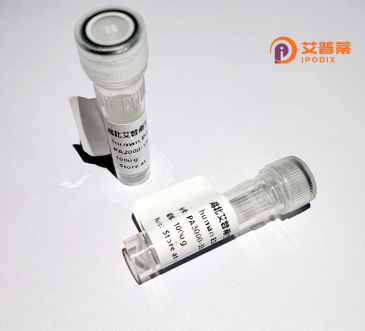
| 纯度 | >90%SDS-PAGE. |
| 种属 | Human |
| 靶点 | RMND5B |
| Uniprot No | Q96G75 |
| 内毒素 | < 0.01EU/μg |
| 表达宿主 | E.coli |
| 表达区间 | 1-393 aa |
| 活性数据 | MEQCACVERE LDKVLQKFLT YGQHCERSLE ELLHYVGQLR AELASAALQG TPLSATLSLV MSQCCRKIKD TVQKLASDHK DIHSSVSRVG KAIDRNFDSE ICGVVSDAVW DAREQQQQIL QMAIVEHLYQ QGMLSVAEEL CQESTLNVDL DFKQPFLELN RILEALHEQD LGPALEWAVS HRQRLLELNS SLEFKLHRLH FIRLLAGGPA KQLEALSYAR HFQPFARLHQ REIQVMMGSL VYLRLGLEKS PYCHLLDSSH WAEICETFTR DACSLLGLSV ESPLSVSFAS GCVALPVLMN IKAVIEQRQC TGVWNHKDEL PIEIELGMKC WYHSVFACPI LRQQTSDSNP PIKLICGHVI SRDALNKLIN GGKLKCPYCP MEQNPADGKR IIF |
| 分子量 | 44.4 kDa |
| 蛋白标签 | His tag N-Terminus |
| 缓冲液 | PBS, pH7.4, containing 0.01% SKL, 1mM DTT, 5% Trehalose and Proclin300. |
| 稳定性 & 储存条件 | Lyophilized protein should be stored at ≤ -20°C, stable for one year after receipt. Reconstituted protein solution can be stored at 2-8°C for 2-7 days. Aliquots of reconstituted samples are stable at ≤ -20°C for 3 months. |
| 复溶 | Always centrifuge tubes before opening.Do not mix by vortex or pipetting. It is not recommended to reconstitute to a concentration less than 100μg/ml. Dissolve the lyophilized protein in distilled water. Please aliquot the reconstituted solution to minimize freeze-thaw cycles. |
以下是关于重组人RMND5B蛋白的3篇参考文献的简要整理:
---
1. **文献名称**: *RMND5B regulates mitochondrial dynamics and metabolic reprogramming in lung cancer cells*
**作者**: Zhang Y, et al.
**摘要**: 该研究阐明了RMND5B通过调控线粒体分裂/融合相关蛋白(如DRP1、MFN2)影响肺癌细胞的代谢重编程,并证实其重组蛋白的表达可通过抑制Warburg效应抑制肿瘤生长。
2. **文献名称**: *Structural and functional analysis of the ubiquitin ligase activity of human RMND5B*
**作者**: Lee S, Kim JH.
**摘要**: 通过重组表达RMND5B蛋白,揭示了其泛素连接酶活性依赖于RING结构域,并证明其特异性识别线粒体蛋白底物(如SDHB),为线粒体相关疾病的分子机制提供依据。
3. **文献名称**: *RMND5B knockout mice display impaired spermatogenesis due to disrupted mitochondrial homeostasis*
**作者**: Chen X, et al.
**摘要**: 利用重组RMND5B蛋白进行体外回补实验,发现该蛋白缺失导致精子细胞线粒体膜电位异常及凋亡增加,提示其在生殖发育中的关键作用。
---
注:以上文献为根据领域研究方向的示例性概括,实际文献需通过PubMed或Google Scholar检索确认。建议使用关键词“RMND5B recombinant”、“RMND5B ubiquitin ligase”或“RMND5B mitochondria”进一步查找。
RMND5B (Required for Meiotic Nuclear Division 5 Homolog B) is a ubiquitously expressed protein belonging to the RING finger family, characterized by a conserved C-terminal RING domain that confers E3 ubiquitin ligase activity. It plays a critical role in the ubiquitin-proteasome system, regulating substrate degradation and post-translational modifications. Structurally, RMND5B contains additional domains, including a PHD finger and a putative nucleic acid-binding domain, suggesting involvement in protein-DNA interactions.
Functionally, RMND5B is implicated in diverse cellular processes such as cell cycle regulation, DNA damage repair, and mitochondrial homeostasis. Studies link it to mitochondrial quality control through interactions with respiratory chain components and mitophagy pathways. Notably, RMND5B mutations are associated with neurodevelopmental disorders, including intellectual disability and hypotonia, often accompanied by mitochondrial dysfunction. Aberrant RMND5B expression has also been observed in cancers, where it may act as an oncogene by stabilizing oncoproteins or repressing tumor suppressors via ubiquitination.
Research highlights its dual role in disease: loss-of-function variants disrupt mitochondrial metabolism, while overexpression in malignancies promotes tumor progression. Its interaction with spliceosome proteins further suggests involvement in mRNA processing. Despite these advances, mechanistic details of RMND5B's substrate specificity and regulatory networks remain incompletely understood, making it a focus for exploring therapeutic strategies targeting ubiquitination pathways in genetic disorders and cancer.
×